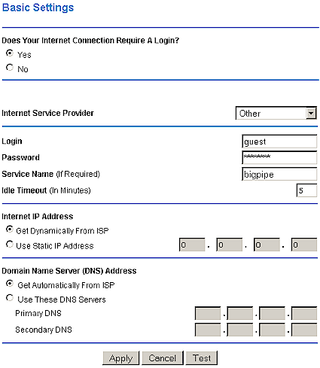Hardware Router Need To Know 2006
Everyone with a high-speed Internet connection needs a router. So why not learn how to choose the one that best meets your needs? We've updated and expanded our classic Hardware Router Need To Know to help you do just that!
ISP Authentication - PPPoE
Your ISP uses a number of methods to make sure that only valid users connect to their systems. We'll next review the common ones.
Point-to-Point Protocol over Ethernet, or PPPoE has become very widely used, driven into the market by DSL BSP's. It requires a user name and password, but uses a protocol that allows the authentication, monitoring, and control of multiple virtual connections. This means that it if your BSP uses this protocol, they could eventually keep track of and charge separately for multiple users. But since they could do this only if you purchased multiple IP addresses from them, this charge-per-user option hasn't been widely implemented, since most users install a router when they want to share the connection.

Figure 2: PPPoE Connection Options
PPPoE is now standard on all routers, but the quality of implementation, i.e. how well it works, varies greatly. Some of the PPPoE related problems are due to buggy router firmware, and some are due to the wide variety of PPPoE implementations used by BSPs. If your BSP uses PPPoE, look for routers that support it, and also that have these other features (refer to Figure 2):
Connection Controls
These include a number of different features, intended to give you control over how long a connection is maintained when there is no network activity and what is done if you are disconnected. Most routers default to automatically connecting when Internet related network activity is detected, but the Linksys routers put this under the control of a "Connect on Demand" setting. "Maximum Idle Time" settings control the time that the router waits to drop the connection when there is no Internet related network activity. An "Auto-Reconnect" feature automatically tries to restore the connection when it's dropped.
Keep Alive
Sign up to get the BEST of Tom’s Guide direct to your inbox.
Upgrade your life with a daily dose of the biggest tech news, lifestyle hacks and our curated analysis. Be the first to know about cutting-edge gadgets and the hottest deals.
One of the very common problems with PPPoE connections is that the connection is frequently dropped. Some BSPs do this intentionally, much as a dialup ISP will drop your connection after a certain period of inactivity, but others just don't have their PPPoE servers set up properly. A "Keep Alive" feature will try to keep the connection up by forcing a short burst of Internet activity after a programmable period of time.
Other PPPoE needs
Depending on your BSP, your Router's PPPoE client may have to provide a Static IP address, and/or Service Name. Make sure your router has these controls if you need them. If you need PPPoE with Static IP, don't assume that your router supports this, since many don't.
Also, check to see if your router supports adjustment of its MTU (Maximum Transmission Unit) value. A PPPoE connection has a lower MTU than a normal Ethernet connection, and can cause problems with some ISPs and/or applications. PPPoE and VPN are a particularly troublesome combination, but there are other cases in which the ability to tweak your router's MTU will come in handy. Note that you may have to hunt through many router admin screens to find the MTU adjustment, since manufacturers are not consistent in where they place it.
Current page: ISP Authentication - PPPoE
Prev Page WAN Port Features Next Page ISP Authentication - Other MethodsTom's Guide upgrades your life by helping you decide what products to buy, finding the best deals and showing you how to get the most out of them and solving problems as they arise. Tom's Guide is here to help you accomplish your goals, find great products without the hassle, get the best deals, discover things others don’t want you to know and save time when problems arise. Visit the About Tom's Guide page for more information and to find out how we test products.
